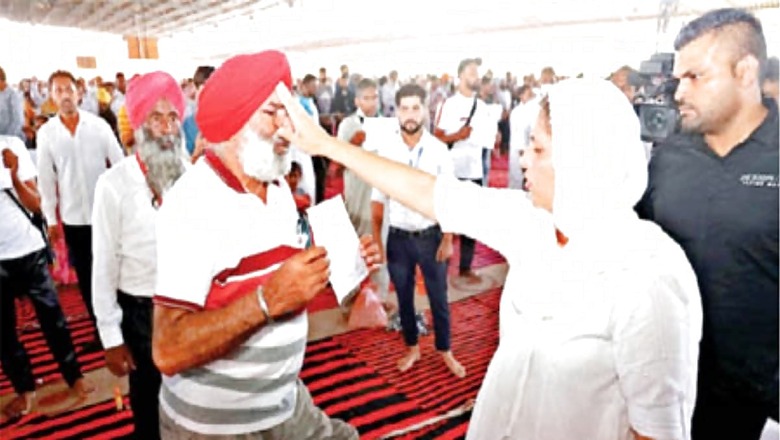
views
Christmas is celebrated all over the world on December 25. India, too, is home to some of the oldest settlements of Christians, with Kerala having an ancient Syrian Church and following in present times. The number of Christians have increased due to increased missionary activities and proselytisation. Punjab has also seen its fair share of Christian conversions, like all other states. For the outer world, Punjab is commonly characterised by its Sikh faith, food, music, philosophy, and folk dances. According to the Punjab Religion Census of 2011, Sikhs constitute a majority religion in the state with approximately 58 percent of the share, Hindus are 38 percent, Muslims are nearly 2 percent, and Christians at 1.26 percent.
However, media reports and Christian leaders argue that the actual number of faith followers is between 10-15 percent. The big gap in the calculation has emerged from the fact that the converts originally belonged to vulnerable communities such as the Dalits. The converts keep their original identity to enjoy the benefits of reservation and miss out on their current religion in the census.
Christianity in Punjab: Now and Then
Christianity in Punjab is not new, as it entered the state in 1834 and has stayed as a socio-cultural force. The initial set of Christians in Punjab was predominantly urban, literate, and socially diverse. However, the focus of present-day conversions is specifically on the large population of marginalised population of the Dalits and other vulnerable caste groups. A mass conversion movement of rural Dalits transformed a predominantly urban community of Christians into a rural and backward community. The reason behind the community being backwards in a relatively forward state is due to the conversions of Dalits. The converts inherit their past identities and follow customs, traditions, and lifestyles as they did in their previous religion. Therefore, Punjabi Christians are now characterised as backward, economically unstable, illiterate, and less urbanised.
Dalits and Valmiki Hindus, along with Mazhabi Sikhs, are converting to Christianity in large numbers as they believe their original religions do not provide them with solace as Christianity does. Dalits and Valmiki Hindus allege that their communities still suffer the consequences of rigid caste structures. The surprising case is that of Mazhabi Sikhs, who have already converted from Hinduism and gone to Sikhism. Sikhism is preached as a religion of equality; however, the story is different on the ground. In rural areas, many Gurudwaras of various denominations can be seen in a single village, such as Ravidas Gurudwara, Jatt Gurudwara, and Mazhabi Sikh Gurudwara. In reality, Sikhism is not an equalising religion, as the upper-caste Jatts look down upon Mazhabi Sikhs and treat them differently. Such discrimination has become a root cause for Mazhabi Sikhs to leave the Sikh faith behind and embrace Christianity. The Shiromani Gurdwara Parbandhak Committee (SGPC) came to take notice of conversions in 2012, when 40 Mazhabi Sikhs converted to Christianity in the Taran Taran district. The head of Akal Takht, Sardar Harpreet Singh, had said that there is no doubt that the followers of the Christian faith are increasing; however, the pressing issue that needed attention was that the Hindu and Sikh communities should analyse why the Dalits, Valmiki Hindus, and Mazhabi Sikhs were leaving their religions.
Church preachers fill the vacuum left by other religions and introduce vulnerable groups to a new religion and faith of Christianity. Hindu and Sikh organisations allege that these preachers take in people on the pretences of healing the sick, bringing back the dead, and so on. The allegations have also led to violent clashes as Punjab witnessed a series of clashes and protests between the Christians and the radical Nihang Sikh communities in November 2022. Earlier in August, a Catholic Church was vandalised, and the car of a Church functionary was set on fire in Patti, Taran Taran.
Conversion at the cost of social relations
The recent conversions have created a scenario of communal hatred in Punjab as Christian groups are targeting vulnerable communities. Moreover, the distorted number of Christians on census data leads to misinformation as the converted communities retain their original identity in documents to avail the benefits of reservation. Hindu and Sikh organisations allege that the missionaries use monetary influence to lure people from vulnerable communities. There have been videos circulating widely on social media sites of people being cured miraculously of their diseases as soon as they embrace Christianity. It is believed that almost all villages have one or two converted Christian families in Punjab. Over 65,000 missionaries are active in the state.
The conversions have severely impacted social relations as people from other religions see the converted Christians as unfaithful towards their religion. The demographic change in the state of Punjab has become starkly apparent as the population has increased by 14 percent since the last census in 2011. With the population growth, there has also been a rise in religious denominations, as a notable decrease in the number of Sikhs from a previous 59 percent to a recent 57 percent is visible. The decrease in the Sikh population has ultimately added to the population of Christians in Punjab.
Another impact of rampant Christianisation has been the appropriation of the social landscape as Christian missionaries have designed churches on lines of Sikh gurdwaras to attract people from other religions. The pastors and Church leaders have also composed songs praising Jesus on lines of Sikh kirtan. The cultural appropriation being done by Church is putting the practices of the Sikh and Hindu faiths in a dilemma. A case in point is that of Khambra village of Jalandhar district, where Pastor Ankur Narula has taken up the responsibility of converting others by setting up the ‘Ankur Narula Ministry.’ The Church of Signs and Wonders has become a prime example of rapid conversion as the establishment has gone from having three members in 2008 to having more than three lakh members in 2022.
Role of Social Media
Technology is developing at an unprecedented pace, and so the population is getting accustomed to its usage. The Christian missionaries operating in Punjab are carefully utilising social media and have a considerable presence on various social media applications such as Facebook, Twitter, and YouTube. The accounts share videos of people healing from illness, treating deaf or hard of hearing, and individuals who used a wheelchair getting up. Such videos have been used to propagate the powers of alleged healers. Church leaders also share information about Sunday masses on social media and invite people for joint prayer.
The extensive presence on social media signifies the deep pockets that Christianity has managed to get in the past few years. Most of the Twitter accounts had joined only recently, in 2020, when the pandemic struck the world. The lockdown allowed missionaries to target the poor by distributing food grains and other essential items. After the withdrawal of lockdown measures, the footfall at various churches in Punjab has drastically increased as people have come in contact with others.
Way Forward
The reaction from the authority figures of Sikh and Hindu communities has been abysmal at most. As elucidated in the above section, the main reason behind the increase in the rate of conversions is the social inequality in the Sikh religion. In recent times, SGPC, the temporal authority of the Sikh religion, has failed to bring together Sikhs from all backgrounds due to its political motives. The over-indulgence of political parties in religious matters has distorted the events revolving around conversion. The program started by SGPC, where Sikh Jathedar goes door-to-door and preaches the Sikh way of life, has not achieved success as Christian leaders have recently filled the vacuum. Hindu leaders are also yet to take heed of the matter.
The need of the hour is to make the vulnerable groups feel equal with other members of the community without any discrimination. The social inequalities in terms of different gurdwaras for Sikhs and Dalit Sikhs have sparked the debate around the Sikh religion and its adherents being casteist. Dalits, Mazhabi Sikhs, Valmiki Hindus, and all other communities should be given the same respect and stature in society as it helps (maintain harmonious social relations. Christian leaders are taking advantage of a broken society infested by casteism and inequality and converting people rapidly.
The issue is not with the Christian religion, as the Indian Constitution gives freedom to propagate religion. However, how church groups and pastors appropriate other religions and cultures severely threatens their existence. Sikhism was created on a rhetoric of establishing a caste-less society; however, no religion in the Indian subcontinent can survive without its caste characteristics. The SGPC, Akal Takht, and other Hindu organisations must act together to contain the society’s mass conversions of the lower strata.
The author served as a Research Intern at the Indian Council of World Affairs, New Delhi (ICWA). Her area of research includes the Indo-Pacific, India-US relations, Indian diaspora, India’s national security, and contemporary Punjab. Currently, she is pursuing her Master’s in International Studies from CHRIST, Bangalore. Views expressed are personal.
Read all the Latest Opinions here



















Comments
0 comment